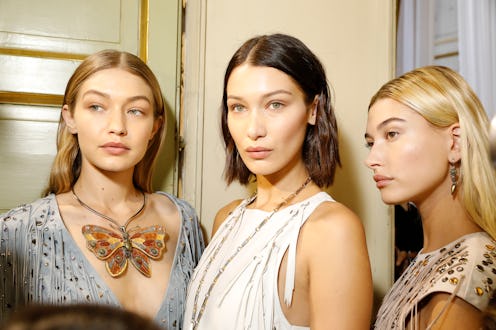TikTok Trends
TikTok's “Clean Girl Aesthetic” Isn't As Inclusive As You Think
Some creators have labelled the trend “anti-Black”.

If you’ve been scrolling through TikTok lately, chances are you’ve come across the #CleanGirlAesthetic. While it was doing the rounds on fashion TikTok, it has finally made its way into the beauty sphere and has now racked up over 200 million views. The trend, which became popular in 2021, has seen a resurgence in popularity and is now dubbed as the Gen Z update to the no makeup makeup look, inspired by off-duty model makeup looks seen on everyone including Bella Hadid, Gigi Hadid, and Hailey Bieber.
According to TikTok, the clean girl only uses tinted moisturisers, BB creams, eyebrow pomades, natural-looking blushes, and lip balms, tints, and oils. The trend is reminiscent of Glossier’s “you, but better” trend, which is probably why you’ve spotted creators using the brand’s Boy Brow, Balm Dotcom, and Cloud Paint to create their “put together” looks.
The trend also links to the hashtag #thatgirlaesthetic, where it’s not only about having perfect minimal makeup but also the perfect organised life that consists of eating well, actively exercising, and living in tidy homes. That all sounds great, right?
But Black and brown creators on the app have pointed out that the clean girl aesthetic trend is not as inclusive as it makes out to be. Influencer @uchjn even went so far as to label the trend “anti-Black”. She wrote: “That clean girl look is low key anti black because which black girl is leaving the house with just tinted moisturiser and a dash of concealer... PLEASE we need coverage and structure.” While others pointed out that many of the tinted moisturisers and BB creams available to buy on the market are rarely affordable, let alone offer a diverse range of shades for darker skin tones. While others struggle with skin conditions such as acne and hyperpigmentation.
User @its.katouche_ explained the point even further on TikTok: “The clean girl look might suffice for somebody who closer adheres to the beauty standard but if you don’t then you’ll be vilified for not going out of your way to over perform femininity,” she said. “The clean girl look relies on certain prerequisites in terms of how you’re supposed to look; to me it’s very reminiscent of a really Victorian puritanical, colonial perception of beauty being pure.”
However, @BlackBallad countered the point on TikTok, arguing that while heavier makeup is seen as artistic expression or a barrier between yourself and self-esteem, the choices that we make when it comes to beauty is political. “The uncomfortable fact is that beauty is power. Studies show that beautiful people access higher grades and better jobs are perceived as more social and more intelligent. So the assertion that Black women can’t partake in the trend serves as a reminder that racism, colourism, fatphobia, transphobia, govern our standards of beauty, that we have to work harder to be afforded this social capital.”
When western beauty standards are the centre of most trends, then naturally those with lighter complexions are celebrated. But that hasn’t stopped Black creators from jumping in on the trend anyway, creating their own hashtag such as #cleanmakeupforblackgirls or #cleangirlaestheticblackgirl. Creator @iamdodos_ can be seen effortlessly rocking the clean girl aesthetic using Black-owned beauty brand Ami Cole’s Skin Enhancing Tint in her beauty tutorial, highlighting that there are products that can be used that are suitable for darker skin tones. While other videos have attracted comments praising the alternative routine, with one user commenting: “"Yessss a Black version 😭😭😭✋u a life saver."
This article was originally published on